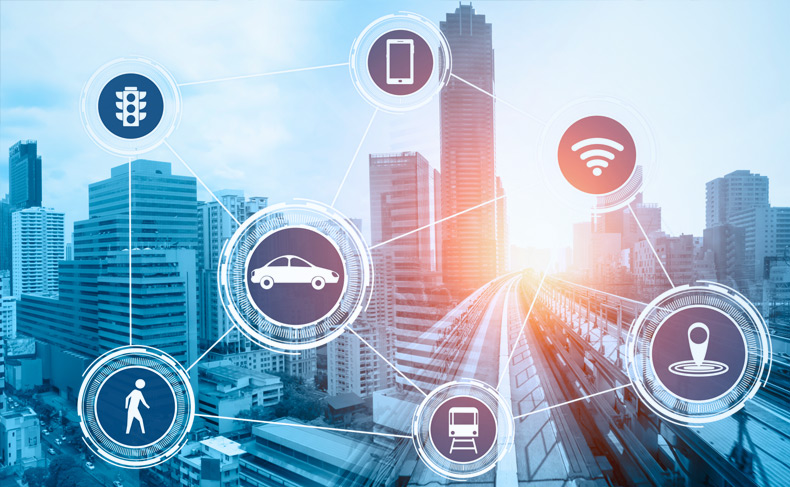The transportation sector has evolved significantly due to technological advances, sustainability goals, and changing consumer preferences. This has redefined mobility by creating a more connected, efficient, and environment-friendly future. India is also adopting advanced technologies, data-driven solutions, and eco-friendly initiatives to pave the way for an integrated and green mobility future.
Revolutionising Mobility: Electrification, Connectivity, and Mobility-as-a-Service
Three key pillars drive the mobility landscape: Electrification, connected and autonomous vehicles (CAVs), and mobility-as-a-service (MaaS). Together, they are reshaping transportation, making it environment-friendly, efficient, and convenient.
Electric Vehicles (EVs) and Alternative Powertrains: The surge in electric vehicles indicates a strategic move towards transportation sustainability. EVs offer a cleaner alternative to traditional internal combustion engines powered by alternative sources such as electric batteries and hydrogen fuel cells. Battery advancements have increased their practicality for everyday use, lowering carbon emissions and spurring innovation in charging infrastructure for greener mobility.
Connected and Autonomous Vehicles (CAVs): Connected and autonomous vehicles promise to make transportation safer and more efficient. Connectivity allows vehicles to communicate with each other and the infrastructure, thus improving traffic management and safety. This autonomous technology has the potential to transform urban mobility by reducing congestion while providing convenience and safety.
Mobility-as-a-Service (MaaS): MaaS is reshaping transportation access by combining multiple modes into a user-friendly platform. It combines public transportation, ride-sharing and bike-sharing while providing users with real-time information, seamless booking, and integrated payment options. MaaS optimises resources and reduces congestion in cities.
Disruptive Trends & Technologies Transforming the EV Industry in India
The Indian Electric Vehicle (EV) industry is experiencing an unprecedented surge, fuelled by the government's ambitious green mobility agenda and the consumers' heightened concern for sustainability. The government's generous incentives, totalling $3.4 billion, have accelerated EV adoption at a breakneck pace. In the last three years, India has seen a phenomenal 2,000% increase in EV sales, indicating a bright and promising future for this booming industry.
According to the Government of India, the country had nearly 1.7 million electric vehicles, with the number steadily rising. The EV market in the country is estimated to reach $7 billion by 2025. In sync with this growth, the EV finance industry will likely reach $50 billion by 2030. The segment will attract investment across vehicle manufacturing and charging infrastructure. Meanwhile, the industry is witnessing specific trends that will shape the EV industry in India and propel it to new heights.
Battery Technology & Manufacturing: The 'India Battery Manufacturing Vision' released by the India Energy Storage Alliance (IESA) aims to achieve a capacity of over 500 GWh by 2035. This can generate over 2.6 million jobs and $35 billion in investment. Battery manufacturers in India are already working to develop advanced energy storage, green hydrogen, and e-mobility technologies. IESA expects the first gigafactory in the country to begin commercial production in 2024, with its production capacity scheduled to touch 50 GWh by 2027-28. With the right policy and regulatory framework, the Indian battery supply chain industry could reach a manufacturing capacity of over 1,000 GWh.
Wireless Charging: The EV industry relies heavily on charging infrastructure. Wireless charging infrastructure will be more widely available by 2024, making the charging of EVs more convenient. This advancement will ease the primary source of range anxiety EV owners suffer and allow them to drive longer distances without the fear of running out of power. Furthermore, wireless charging eliminates the need for manual charging cable plugging and unplugging, resulting in a safer and more streamlined charging experience that could reduce total energy costs by up to 50%.
Autonomous Driving: Autonomous driving has the potential to improve safety, reduce traffic congestion, and improve the driving experience. Advanced driver assistance systems (ADAS) and automatic parking systems (APS) can enhance driver convenience and safety. Furthermore, advances in ADAS and APS are not limited to conventional fuel-powered vehicles; they are also being integrated into electric vehicles. The incorporation of ADAS technology into EVs has the potential to increase efficiencies, boost performance and improve safety. As a result, the electric vehicle industry is rapidly pushing the limits of ADAS technology, paving the way for a future dominated by more sophisticated and intelligent autonomous driving systems. The ADAS market is predicted to be worth $4.17 billion by 2027.
Vehicle-to-Grid Technology: Vehicle-to-grid technology (V2G) is a game changer in India's electric vehicle industry. V2G will generate a staggering $28 billion by 2026, significantly contributing to the industry's growth. EVs can function as energy storage units with V2G, supplying power back to the grid during peak demand, reducing strain and providing a cost-effective solution critical for India's increasing energy needs.
Artificial Intelligence: AI-powered electric vehicles will dominate the market by 2024, with superior performance, safety, and efficiency. The potential for AI to revolutionise the EV industry is limitless as companies invest in self-driving cars that use cutting-edge Deep Learning technology. We can expect to see increasingly innovative applications that make EVs smarter, safer, and more efficient than ever before.
Conclusion
The convergence of electrification with connected and autonomous vehicles, and Mobility-as-a-Service propels a transformative shift in mobility, fostering environmental sustainability, efficiency, and convenience. Anticipated tech trends, including advancements in battery technology, autonomous driving, wireless charging, vehicle-to-grid technology, and the integration of artificial intelligence, are poised to redefine the EV industry in India. With these innovations, the future promises a greener, more efficient, and intelligent mobility ecosystem that aligns with the evolving needs of both consumers and the environment.
To learn more about the future of mobility, join us at the 9th Smart Cities India & 31st Convergence India exhibition and conferences, scheduled from 17-19 January 2024 at Pragati Maidan, New Delhi. Esteemed speakers such as Shri Deepak Shinde, Joint Secretary, IAS, Ministry of Road Transport & Highways, Mr. CV Raman, CTO, Maruti Suzuki, Mr. Shashank Srivastava, Sr. Executive Director, Maruti Suzuki, and Mr. Puneet Anand, Associate VP, Hyundai Motor India will delve into the transformative tech trends shaping the EV industry in India. Be there to explore mobility's green, efficient, and intelligent future with these industry visionaries.
